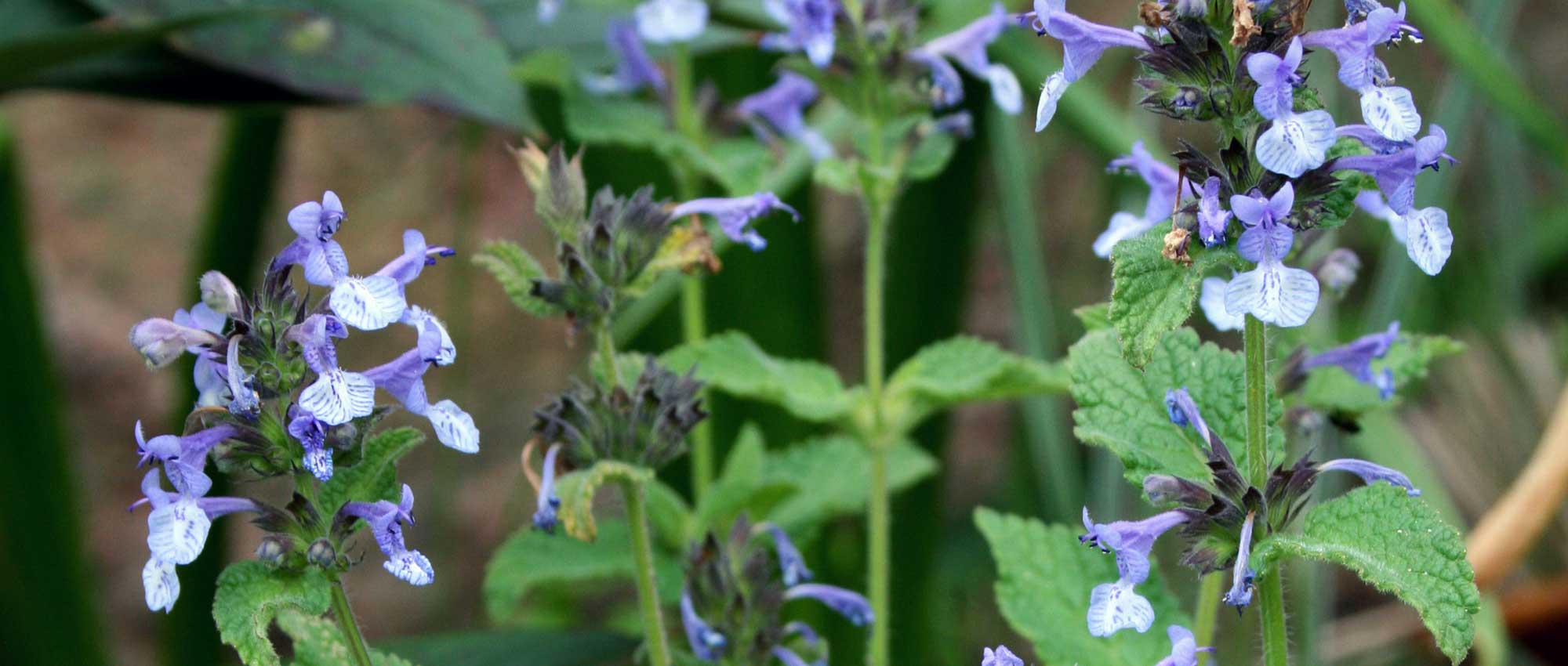
Nepeta, cat mint: planting, cultivation, pruning and maintenance
Contents
Nepeta in a nutshell
- Nepeta offers an abundant and very long flowering period, lasting all summer long!
- The flowers are often blue-mauve, but can also be white, pink, or yellow.
- Its aromatic foliage can be harvested and consumed as herbal tea.
- It is a very easy plant to grow, requiring little maintenance.
- Its highly melliferous flowering is appreciated by bees.
- Nepeta has an euphoric effect on cats!
A word from our Expert
Also known as Catnip, Cat Herb or Cat Mint, Nepeta is a remarkable perennial plant renowned for its very long summer flowering period, often in blue – mauve. This perennial will provide you with around five months of flowers! Its foliage is fragrant, aromatic, and highly appreciated by cats, and it can also be used in herbal tea (for its medicinal properties)! Additionally, nepeta has the advantage of being a good melliferous plant! There are many horticultural varieties available, allowing you to choose from different shapes and heights. For example, discover the stunning Nepeta faassenii ‘Six Hills Giant’, a vigorous variety with lavender-blue flowers and grey foliage!
Nepeta thrives when planted in full sun, in well-draining soil. It hates winter moisture! This plant is perfect for Mediterranean-style gardens and dry gardens, but it can also be placed in a mixed border, in rockeries, or in a large pot or container. It is a versatile plant that suits many different situations. Its long mauve-blue flower spikes make nepeta an excellent candidate to replace lavender in areas that are too cold and damp for it! Nepeta has the advantage of being a hardy perennial that requires almost no maintenance!
Botany
Botanical data
- Latin name Nepeta sp.
- Family Lamiaceae
- Common name Catmint, Cat herb, Cat mint, Cataria, Chataire
- Flowering from May to September - October
- Height often between 30 and 90 cm
- Exposure full sun
- Soil type draining
- Hardiness at least down to -15 °C.
The catmints comprise around 250 species of herbaceous plants, generally perennials, although a few annual species can also be found. The most well-known are Nepeta cataria and Nepeta faassenii. There are over a hundred horticultural varieties cultivated in gardens. Catmints are primarily found in the Northern Hemisphere, particularly in Europe and Asia, as well as in Africa. A few species have naturalised in North America. Several species of catmints can be encountered in the wild in France, including Nepeta cataria. It grows in meadows, clearings, fallow land, and wastelands, as well as along roadsides.
Catmint has the unique ability to create a temporary euphoria in cats! They love to rub against it, roll on the plant, and chew its leaves. The true “cat herb” or “cat mint” is Nepeta cataria, but it is not the most common species in gardens, as it is less interesting from an ornamental perspective. Nepeta faassenii, for example, is more frequently cultivated. It is also appreciated by cats.
Catmint belongs to the botanical family Lamiaceae, like sage, mint, lavender, or rosemary. This family includes many aromatic and medicinal plants. These plants are generally well adapted to drought.
Nepeta likely derives its name from the town of Nepet (now called Népi), located in Italy. The species name (cataria) comes from the Latin catus: cat. Its vernacular names also refer to its effect on felines: “cat herb”, “cat mint”, “cataria”, “chataire”… In English, this reference to cats is preserved as the plant is called catnip or catmint. Nepeta cataria should not be confused with Calamintha, Calamintha nepeta, although both plants belong to the same family.
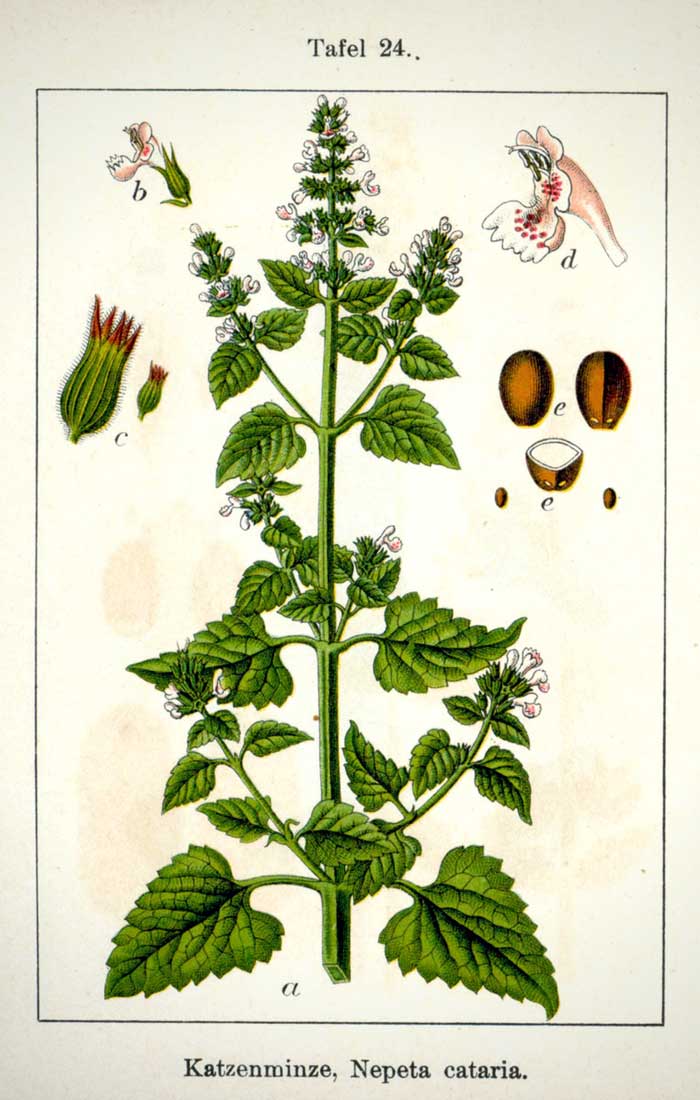
Nepeta cataria: botanical illustration
Catmint grows quickly and forms large clumps, with stems that can sometimes be prostrate or spreading. The plant can thus take on a mat-forming, ground-covering appearance, but it can also be bushy. It makes an excellent border plant, ideal along a path or at the edge of a garden, against a hedge. Generally, its height ranges from 30 to 90 cm. There are a few species and varieties of very small size, such as Nepeta phyllochlamys, which does not exceed 10 cm in height, or Nepeta racemosa, measuring less than 30 cm tall. The variety ‘Six Hill Giants’, one of the tallest, reaches almost a metre high! The numerous varieties of catmints have resulted in a beautiful diversity of shapes and sizes, which adapt to specific situations (borders, ground cover, beds, pot cultivation…).
Catmint is appreciated for its very long-lasting flowering, starting in spring and continuing throughout the summer! It flowers from May, and sometimes until September – October. It is advisable to cut the flowers when they have faded, as this encourages the plant to bloom again.
Catmint is covered with an abundant blue flowering, borne at the top of the stems. It produces long spikes composed of flowers gathered in whorls. The flowers can also be arranged in clusters, cymes, or panicles.
As it bears a multitude of small flowers, catmint has a very airy and light appearance! In summer, when the plant is in full bloom, the green foliage disappears under a cloud of blue-violet flowers.
Catmint has tubular flowers, which divide into two lips, and which are quite characteristic of the Lamiaceae family. The upper lip is small and consists of two lobes, while the lower lip is broader, well-developed, and has three lobes. The calyx has five teeth (five fused sepals). Inside the tube of the corolla, the flower has four stamens that carry the pollen. The size of the flowers is quite variable: those of Nepeta faassenii measure less than one centimetre long, while those of Nepeta ‘Souvenir d’André Chaudron’ can measure up to 4 cm in length. When they are small, the flowering takes on a very airy and light aspect!
Most of the time, the flowering is blue-violet, lavender in colour. There are also a few varieties with yellow, pink, or white flowers, but they are rarer! The nepeta govaniana, for example, offers a very bright yellow flowering, while in nepeta cataria, the flowers are white marked with a few reddish spots. The shades of catmint are generally pale and soft, delicate. They can easily be used to create colour harmonies or contrasts and benefit from being associated with brighter blooms! In Nepeta ‘Dawn To Dusk’, the calyx is decorative, purplish… As it is much darker than the corolla (petals), it is the one that adds colour to the flowering!
The flowering of catmint is melliferous! It is highly appreciated by bees and butterflies, which come to collect the nectar contained in the flower, and in return ensure pollination.

The flowering of catmints! Nepeta subsessilis ‘Pink Dreams’, Nepeta govaniana (photo Scott Zona), Nepeta cataria (photo D. Gordon E. Robertson) and Nepeta faassenii ‘Six Hills Giant’
The leaves of catmint are entire and triangular or cordate in shape (heart-shaped), with a lamina that is either entire or crenate at the edge. They are pubescent, bearing hairs, particularly on the underside. They have a rather delicate, dentate appearance. The leaves are arranged in pairs on the stems, oppositely. The stems have the characteristic of being square, with four angles, like other plants in the Lamiaceae family.
The foliage is green and more or less grey. It is possible to create beautiful effects by associating catmint with other plants with grey foliage, or with much more contrasting foliage, for example black or very dark. The nepeta ‘Six Hill Giant Gold’ stands out for its bright foliage, edged in yellow – gold!
The leaves are aromatic, releasing a characteristic, slightly menthol scent when crushed. This is what gives the plant its name “cat mint”. In Nepeta cataria ‘Citriodora’, they have a lemon scent! The foliage of catmint can be harvested for use in herbal tea! It has medicinal properties, particularly calming and digestive.
The foliage is deciduous, disappearing for the winter. The clumps should be cleaned at the end of winter.

The foliage of catmints is quite decorative! Nepeta cataria (photo Liz West), Nepeta sibirica (photo Drew Avery) and Nepeta x faassenii
After flowering, catmint produces capsules that contain four small oval brown nuts, each containing a seed. However, many varieties are sterile, particularly Nepeta x faassenii.
Catmint is a robust and quite hardy plant, capable of withstanding temperatures between -15 and -20 °C.
Read also
Phlox: planting, growing and careThe main varieties of Nepeta

Nepeta faassenii Walkers Low - Catnip
- Flowering time June to November
- Height at maturity 50 cm

Nepeta faassenii Six Hills Giant - Catnip
- Flowering time July to November
- Height at maturity 50 cm
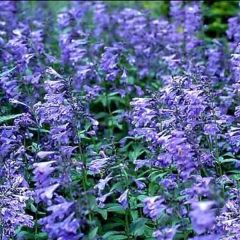
Nepeta sibirica Souvenir dAndre Chaudron - Catnip
- Flowering time June, July
- Height at maturity 60 cm
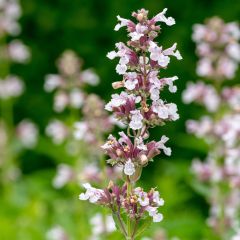
Nepeta grandiflora Dawn to Dusk - Catnip
- Flowering time July to October
- Height at maturity 80 cm
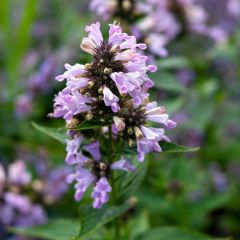
Nepeta subsessilis Sweet Dreams - Catnip
- Flowering time July to September
- Height at maturity 70 cm
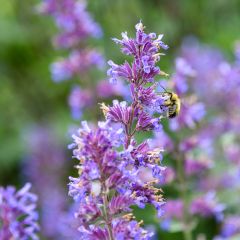
Nepeta racemosa Grog - Catnip
- Flowering time June to October
- Height at maturity 35 cm
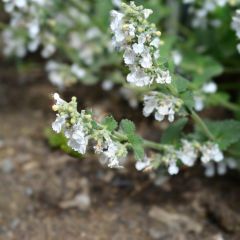
Nepeta racemosa Snowflake - Catnip
- Flowering time July to October
- Height at maturity 40 cm
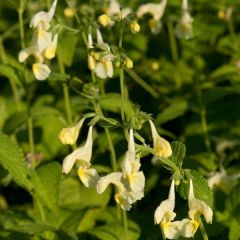
Nepeta govaniana - Catnip
- Flowering time September to November
- Height at maturity 1,20 m
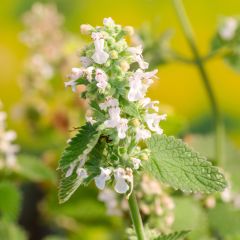
Nepeta cataria Citriodora
- Flowering time July to October
- Height at maturity 60 cm
Discover other Nepeta - Catnip
View all →Available in 2 sizes
Available in 3 sizes
Available in 2 sizes
Available in 1 sizes
Available in 3 sizes
Available in 4 sizes
Available in 2 sizes
Available in 1 sizes
Available in 1 sizes
Available in 1 sizes
Where, when, and how to plant nepeta
Where to plant?
Plant your nepeta preferably in full sun, although they can also tolerate partial shade if the light is sufficient. If you place them in a sunny spot, they will provide a more beautiful and generous flowering, as well as a more fragrant foliage, than if they are in the shade.
Nepeta prefers relatively poor soils. If you plant it in overly rich ground or add fertiliser, the plant will have a softer, less structured appearance, and its flowering may be somewhat less abundant. It can even be planted in stony or sandy soil. It is important that the substrate is well-draining. Soil that retains water in winter (heavy, clayey soils…) could cause the roots to rot.
Nepeta subsessilis and govaniana (as well as the varieties derived from them) tolerate shade and cool, even moist, soils better than other species.
As nepeta forms wide, spreading clumps, we suggest not planting it too close to other plants. Over time, it may smother them.
Since cats sometimes tend to damage them by rolling in them, you can install a small fence around a few plants to protect them. Similarly, if you plan to harvest the leaves for use in herbal tea, it is better to place a few plants out of reach of cats.
Conversely, you can also choose to grow nepeta for your cats! You can place it near the house to watch them roll in it.
Compact and spreading varieties, such as ‘Walker’s Low’, deserve to be planted at the front of a border, in a bed, or as ground cover, while others, like ‘Six Hills Giant’, will find their place in the middle of a border! Nepeta is ideal along a path, to colour the edge of a walkway. You can also grow it in a large pot or container, but choose the most compact varieties for this. As it tolerates poor soils and drought well, it can also be planted in a rock garden or mineral garden, where it can replace lavender, for example.
Nepeta can be used to green up a difficult and poor, stony area. You can also use it to cover a bank.
When to plant?
It is best to plant nepeta in spring, in April or May. If you live in the south of France, you may consider planting it in autumn, around September – October (in regions where winter is cold and damp, the roots may rot if you plant in autumn).
How to plant?
Maintain at least 40 cm of distance between two plants, although this may vary depending on the species being grown.
To plant:
- Prepare the soil to loosen it and remove weeds.
- Dig a hole two to three times the size of the root ball. Improve drainage if necessary by adding gravel or coarse sand.
- Remove the plant from its pot and place it in the hole.
- Fill in around it with soil.
- Water generously.
It is advisable to continue watering regularly during the first few weeks. You can pinch the young shoots to encourage a bushier habit. If planting in a pot, remember to install a drainage layer at the bottom (gravel, broken pot pieces, clay balls…).
Also discover our planting tips – How to plant perennials?
maintenance: watering, pruning, diseases
Nepeta is an easy plant that requires little maintenance. However, you can water during prolonged dry spells, but without excess, allowing the substrate to dry out between waterings. It is important to avoid water stagnation, as this can cause the roots to rot. Watering should be a bit more regular if you are growing nepeta in pots or containers, as the substrate dries out more quickly! Since nepeta is satisfied with poor soils, it does not need fertiliser.
When the first flowering is finished, we recommend cutting the plant back by about a third or simply removing the faded flower stems, as this will encourage the plant to produce new flowers. Nepeta can thus offer a second flowering, until the end of summer! Then, as nepeta is deciduous, you can cut back the clumps in autumn, but it is also interesting to wait until the end of winter, as the dried foliage provides protection against the cold.
If you are growing the larger varieties, such as ‘Six Hills Giant’, it is best to provide staking.
As the leaves of nepeta are aromatic and have medicinal properties, do not hesitate to harvest them! Preferably do this in spring (when the plant starts to flower), in the morning, on a dry day. You can use them fresh to flavour dishes, or dry them for later use in herbal tea.
Regarding diseases, be cautious of powdery mildew. This is a fungal disease that can affect nepeta, especially if the summer is dry, and is also favoured by poor air circulation (too dense planting). It is recognised by the appearance of a white, farinose fluff on the leaves. Remove the affected parts, prune to allow air circulation, avoid wetting the foliage when watering, and spray a solution based on sulphur or a horsetail decoction.
In the case of a wet and cold winter, it can happen that the roots of nepeta start to rot. Hence the importance of planting in well-draining soil to prevent water stagnation!
Slugs sometimes nibble on the foliage. You can protect your nepeta by making a slug trap or using slug pellets such as Ferramol.
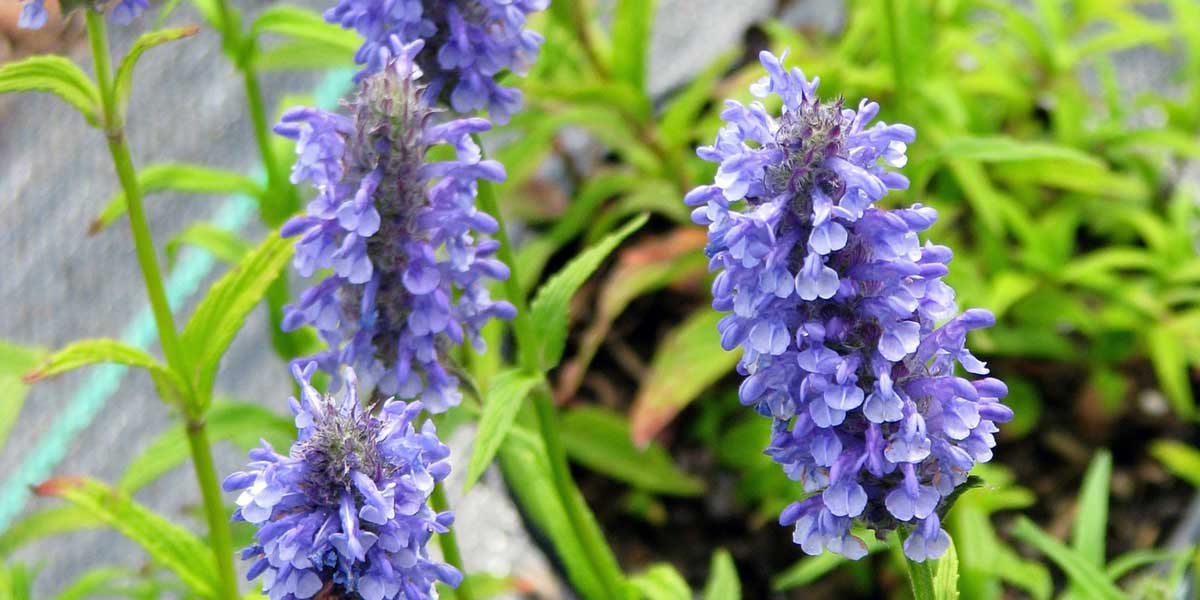
Nepeta nervosa (photo Enking)
Propagating nepeta
It is possible to multiply nepeta by sowing, division, or propagation by cuttings. The latter two techniques allow for the preservation of varieties identical to the mother plant, which is not the case for sowing. Similarly, some varieties (notably Nepeta x faasenii) are sterile and cannot be multiplied by sowing!
Sowing
You can collect seeds from your nepeta plants, or buy them, then sow them at the end of winter – beginning of spring.
- Take a pot or a seed tray, and fill it with seed compost.
- Sow the seeds by scattering them on the surface of the substrate.
- Cover very lightly (a few millimetres are sufficient).
- Water with a fine spray.
- Place the pot in a bright location, where the temperature is between 18 and 20 °C.
- As soon as the young seedlings reach about 5 cm in height, you can transplant them into individual pots.
- You can plant them outdoors in spring, as soon as there is no longer a risk of frost.
It is also possible to sow in early autumn under a cold frame. Collect the seeds and sow them immediately.
Sometimes the plant self-seeds. It is then quite simple to dig up the young seedlings to relocate them to another spot.
Tuft Division
You can divide the tufts at the end of winter – beginning of spring, around March or April. Division has the advantage of regenerating the tufts, thus giving them renewed vigour, but this delicate operation should be performed on plants at least 4 years old.
- Identify a healthy, well-developed tuft that has been in place for several years.
- Dig it out of the ground, using a fork spade.
- Separate the tuft into several fragments.
- Prepare the ground for replanting at another location.
- Install the new plants from the division.
- Water generously.
Propagation by Cuttings
This is the simplest method! You can multiply nepeta by propagation by cuttings of stems around June and July.
- Take a pot and fill it with compost. Water it so that it is well moist.
- Take a stem about ten centimetres long from a nepeta plant, preferably without flowers.
- Remove the leaves at the base. You should only keep a few leaves at the top of the stem. Similarly, if there are flowers or flower buds, remove them.
- Plant the stem in the pot, then firm the soil around it.
- Place the pot in a bright location, between 20 and 25 °C.
- Be patient… Keep the substrate slightly moist until the cutting starts to grow. You can then reduce watering.
Garden associations
Nepeta can be combined with many plants and can find its place in gardens of very different styles. Its green-grey foliage and soft, airy flowering create a stunning contrast with plants in darker or brighter tones.
The best pairing idea seems to be to plant nepeta in front of old roses. The tender colours of nepeta are perfect for complementing the delicacy of roses, and their foliage helps to hide the often bare stems of the roses. With its spreading habit and modest height, nepeta can be placed right in front of a rose without obscuring its flowering! Position alongside some delicately flowering plants (astrantia, gypsophila…) to create a stunning romantic border!
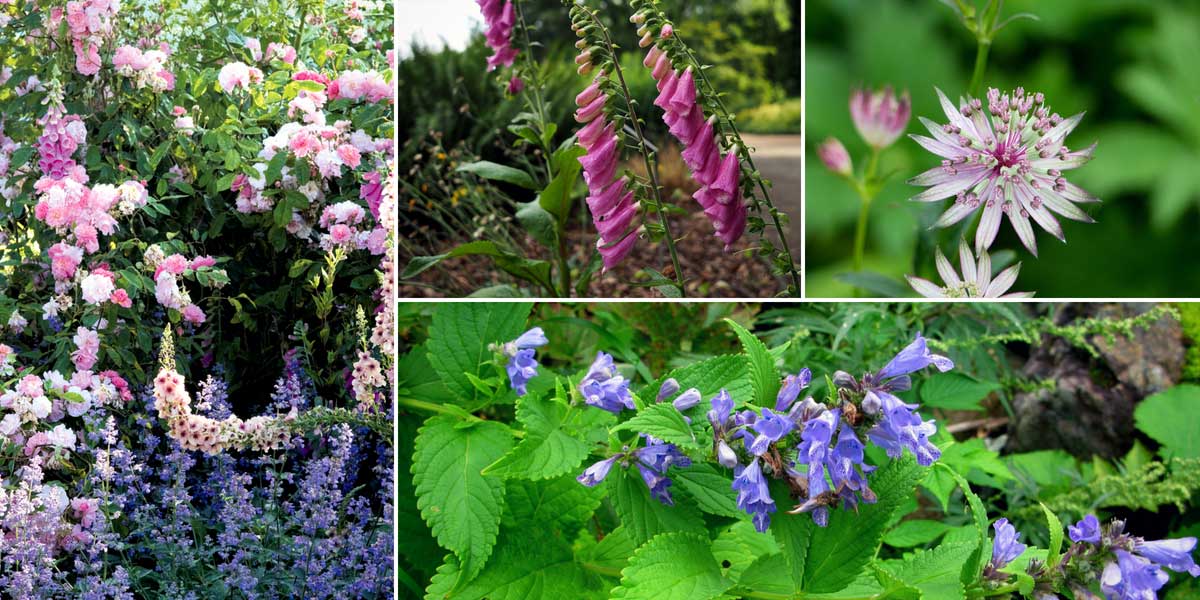
Nepetas can fit into a romantic-style garden, for example with roses and astrantias! Rose ‘Felicia’, Verbascum and Nepeta (Photo GWI – MBP Plants – MAP) / Digitalis purpurea / Astrantia major ‘Ruby Star’ and Nepeta subsessilis)
You can also create a cottage garden style border. Plant nepeta with sages (notably Salvia nemorosa), hardy geraniums, clematis, and Campanula lactiflora. Integrate some plants with tall, upright flower spikes, such as foxgloves, delphiniums, or veronicastrums, to add structure and height! Compose a beautiful scene in blue, mauve, and white tones for a very soft and delicate visual effect. You can add shrubs like Weigela, Spiraea, and Deutzia!
You can plant nepeta in a mixed border to create an English-style border. Combine it with other perennials, mixing colourful blooms! For example, you can place red valerian (Centranthus ruber), Jerusalem sages, Veronica spicata, agastaches, and Phlox paniculata alongside it… Also enjoy the vibrant flowering of helianthemums!
As it thrives in full sun and well-drained soils, nepeta will also find its place in a Mediterranean-inspired garden, where it can replace lavender! You can integrate other aromatic plants, as well as spurges, yarrow, eryngiums, and Stachys. Add some grasses in small clumps (Stipa, Carex, Briza media…). Nepeta is ideal for dry gardens with a mineral focus. You can place it, for example, at the foot of a stone wall facing south, or in the background of a rockery, alongside carnations, houseleeks, moss phlox, and Campanula muralis.
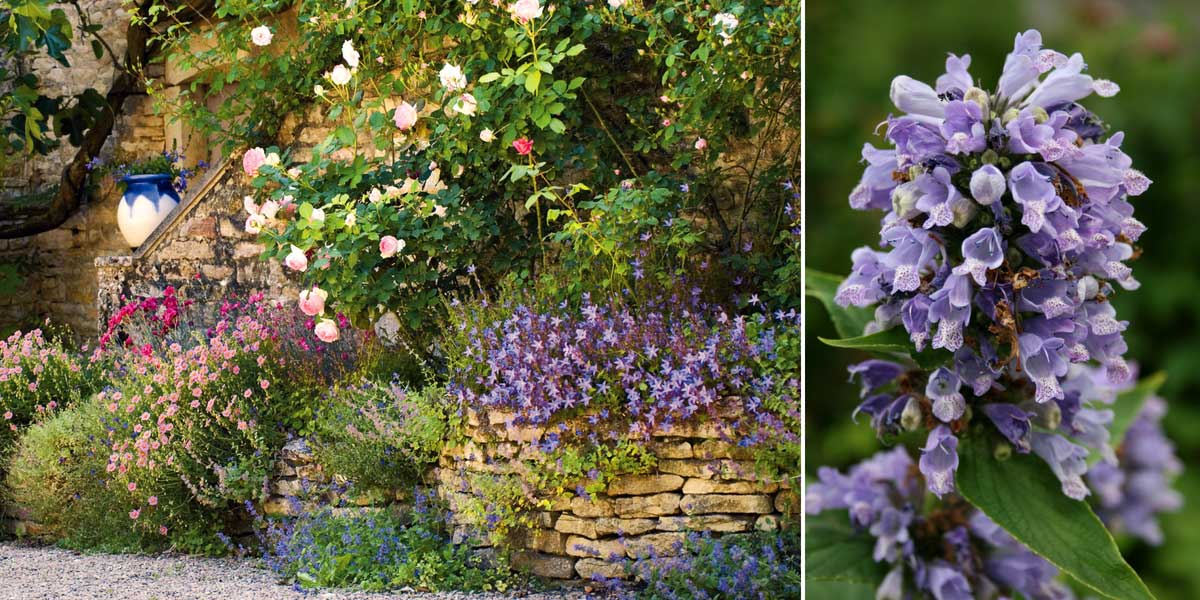
Nepetas can fit into a dry garden or a Mediterranean-style garden. Rose ‘Pierre de Ronsard’, Helianthemum ‘Lawrenson’s Pink’, Campanula, Nepeta racemosa ‘Grog’, and Dianthus allwoodii ‘Romeo’ (photo E. Gonnet – Biosphoto) / Nepeta subsessilis (photo Uleli)
As its hues are quite soft, sometimes a bit pale, do not hesitate to pair nepeta with brighter or more contrasting blooms: daylilies, Centranthus ruber, echinaceas… to enhance the border! Enjoy the intense and deep blue of certain sages, such as Salvia guaranitica!
Similarly, to create an intense and colourful visual effect, you can pair nepeta with yellow or orange blooms. Indeed, these are the complementary colours of purple and blue, two shades often found in Nepeta. This can create beautiful contrasts with yellow blooms, such as that of yarrow ‘Terracotta’, Coreopsis, or rudbeckias.
Did you know?
- A plant that cats adore!
By cultivating catnip, you may notice that cats love to roll in it, lie on it, and chew the leaves. This plant seems to have an aphrodisiac effect on them, temporarily plunging them into a euphoric state! This reaction is thought to be hereditary, so some cats are not responsive. It is estimated that about two-thirds of cats are sensitive to it. Nepeta cataria is their favourite (it is the true “Cat Herb”), although other species have a comparable effect on them (Nepeta grandiflora, Nepeta faassenii…). The chemical substance (terpene) that affects cats is nepetalactone. Even when dried, the leaves remain attractive to cats! You can harvest them and rub the leaves on their toys. Although this plant seems to act like a drug on cats, there is no danger to them!

- Medicinal properties
You can harvest catnip leaves to consume as an herbal tea. It is a plant that is both calming, anti-stress, and stimulating. It is also digestive, antibacterial, useful for infections and breathing problems, and it soothes dental pain. The essential oil derived from Nepeta cataria is said to be very effective as an insect repellent. The leaves can also be used fresh to flavour dishes, and it is possible to infuse wine with catnip leaves.
Useful resources
- Discover our wide range of nepeta!
- Find 6 successful pairing ideas with Nepetas
- Our video tips – How to plant perennials
- Discover other allelopathic plants!
Frequently asked questions
-
The foliage of my nepeta is covered in a white fluff!
It is affected by powdery mildew, a disease caused by a fungus. We advise you to remove the affected parts to limit its spread. You can prune your nepeta and nearby plants to allow for good air circulation. Then treat using a horsetail decoction or a sulphur-based solution.
-
My nepeta's leaves are being nibbled! What should I do?
The culprits are slugs! You can protect your young plants by installing a barrier made of ash or sawdust to keep them away, or by using slug pellets.
- Subscribe!
- Contents

































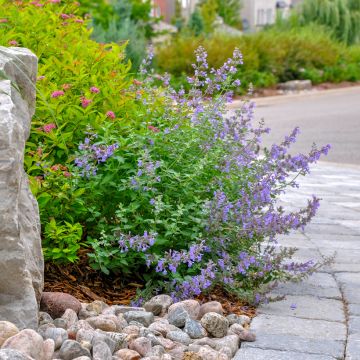
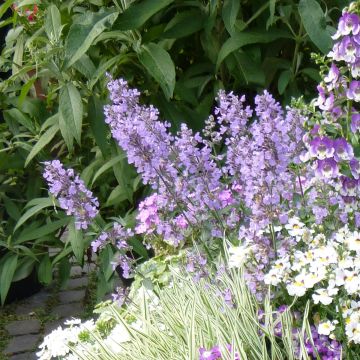
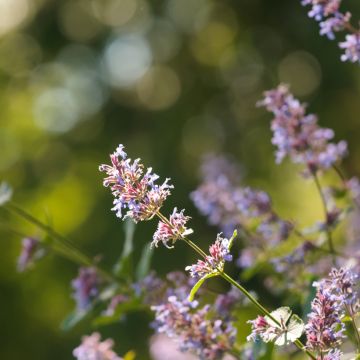

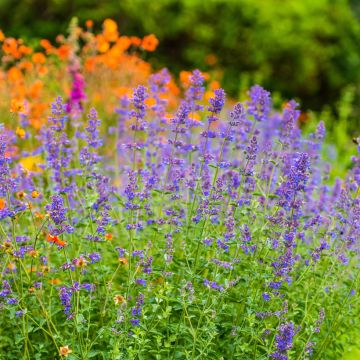

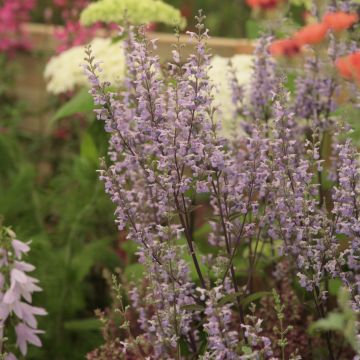


Comments